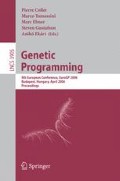Abstract
The use of Constructive Induction (CI) methods for the generation of high-quality attributes is a very important issue in Machine Learning. In this paper, we present a CI method based in Genetic Programming (GP). This method is able to evolve projections that transform the dataset, constructing a new coordinates space in which the data can be more easily predicted. This coordinates space can be smaller than the original one, achieving two main goals at the same time: on one hand, improving classification tasks; on the other hand, reducing dimensionality of the problem. Also, our method can handle classification and regression problems. We have tested our approach in two financial prediction problems because their high dimensionality is very appropriate for our method. In the first one, GP is used to tackle prediction of bankruptcy of companies (classification problem). In the second one, an IPO Underpricing prediction domain (a classical regression problem) is confronted. Our method obtained in both cases competitive results and, in addition, it drastically reduced dimensionality of the problem.
Access this chapter
Tax calculation will be finalised at checkout
Purchases are for personal use only
Preview
Unable to display preview. Download preview PDF.
References
Cristianini, N., Shawe-Taylor, J.: An introduction to Support Vector Machines (and other kernel-based learning methods). Cambridge University Press, Cambridge (2000)
Hastie, T., Tibshirani, R., Friedman, J.: The elements of statistical learning. Springer Series in Statistics. Springer, New York (2001)
Fawcett, T., Utgoff, P.: A hybrid method for feature generation. In: Proceedings of the Eighth International Workshop on Machine Learning, Evanston, IL, pp. 137–141 (1991)
Kramer, S.: Cn2-mci: A two-step method for constructive induction. In: Proceedings of ML-COLT 1994 (1994)
Pfahringer, B.: Cipf 2.0: A robust constructive induction system. In: Proceedings of ML-COLT 1994 (1994)
Koza, J.R.: Genetic Programming: On the Programming of Computers by Means of Natural Selection. MIT Press, Cambridge (1992)
Quinlan, J.R.: C4.5 – Programs for Machine Learning. The Morgan Kaufmann series in machine learning. Morgan Kaufman Publishers, San Francisco (1993)
Douglas Zongker and Bill Punch. lil-gp 1.1 (September 1998), http://garage.cps.msu.edu/software/lil-gp/
Koza, J.R.: Genetic Programming II: Automatic Discovery of Reusable Programs. MIT Press, Cambridge Massachusetts (1994)
Altman, E.I.: Business failure prediction models: An international survey. Journal of Banking Accounting and Finance 8, 171 (1984)
Tam, K.Y., Kiang, M.Y.: Managerial applications of neural networks: the case bank failure predictions. Management Science 38, 926–947 (1992)
Han, I., Jo, H., Shin, K.S.: The hybrid systems for credit rating. Journal of the Korean Operations Research and Management Science Society 22(3), 163–173 (1997)
Fletcher, D., Goss, E.: Forecasting with neural networks: An application using bankruptcy data. Information and Management 24(3), 159–167 (1993)
Vieira, A., Bas, N.: A training algorithm for classification of high-dimensional data. Neurocomputing 50, 461–472 (2003)
Ritter, J.R., Welch, I.: A review of ipo activity, pricing, and allocations. Journal of Finance 57, 1795–1828 (2002)
Jain, B.A., Nag, B.N.: Artificial neural network models for pricing initial public offerings. Decision Sciences 26, 283–299 (1995)
Vieira, A., Ribeiro, B., Neves, J.C.: A method to improve generalization of neural networks: Application to the problem of bankruptcy prediction. In: Springer Verlag series on Adaptative and Natural Computing Algorithms Proceeding of 7th International Conference on Adaptive and Natural, Computing Algorithms. ICANNGA 2005, vol. 1, p. 417 (2005)
Witten, I.H., Frank, E.: Data Mining: practical machine learning tools and techniques with java implementations. Morgan Kaufmann, San Francisco (2000)
Quintana, D., Luque, C., Isasi, P.: Evolutionary rule-based system for ipo underpricing prediction. In: Proceedings of the Genetic and Evolutionary Computation Conference GECO 2005, vol. 1 (2005)
Otero, F.E.B., Silva, M.M.S., Freitas, A.A., Nievola, J.C.: Genetic programming for attribute construction in data mining. In: Ryan, C., Soule, T., Keijzer, M., Tsang, E.P.K., Poli, R., Costa, E. (eds.) EuroGP 2003. LNCS, vol. 2610, pp. 389–398. Springer, Heidelberg (2003)
Krawiec, K.: Genetic programming-based construction of features for machine learning and knowledge discovery tasks. Genetic Programming and Evolvable Machines 3(4), 329–343 (2002)
Shafti, L.S., P´erez, E.: Constructive induction and genetic algorithms for learning concepts with complex interaction. In: GECCO 2005, pp. 1811–1818 (2005)
Kuscu, I.: A genetic constructive induction model. In: 1999 Congress on Evolutionary Computation, pp. 212–217. IEEE Service Center, Piscataway (1999)
Hu, Y.-J.: A genetic programming approach to constructive induction. In: Koza, J.R., Banzhaf, W., Chellapilla, K., Deb, K., Dorigo, M., Fogel, D.B., Garzon, M.H., Goldberg, D.E., Iba, H., Riolo, R. (eds.) Genetic Programming 1998: Proceedings of the Third Annual Conference, University of Wisconsin, Madison, Wisconsin, USA, pp. 146–151. Morgan Kaufmann, San Francisco (1998)
Author information
Authors and Affiliations
Editor information
Editors and Affiliations
Rights and permissions
Copyright information
© 2006 Springer-Verlag Berlin Heidelberg
About this paper
Cite this paper
Estébanez, C., Valls, J.M., Aler, R. (2006). Projecting Financial Data Using Genetic Programming in Classification and Regression Tasks. In: Collet, P., Tomassini, M., Ebner, M., Gustafson, S., Ekárt, A. (eds) Genetic Programming. EuroGP 2006. Lecture Notes in Computer Science, vol 3905. Springer, Berlin, Heidelberg. https://doi.org/10.1007/11729976_18
Download citation
DOI: https://doi.org/10.1007/11729976_18
Publisher Name: Springer, Berlin, Heidelberg
Print ISBN: 978-3-540-33143-8
Online ISBN: 978-3-540-33144-5
eBook Packages: Computer ScienceComputer Science (R0)

